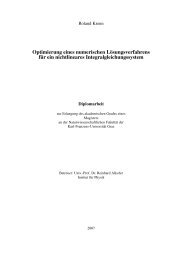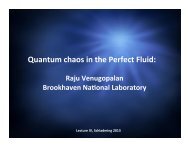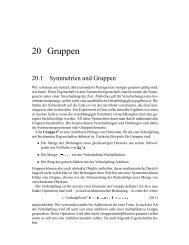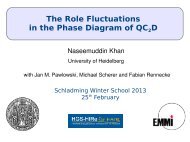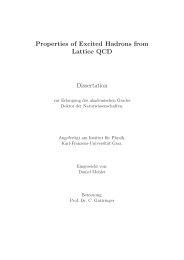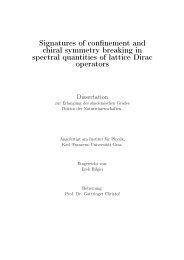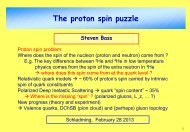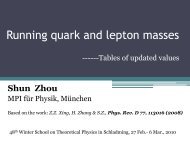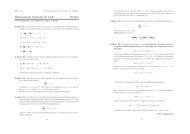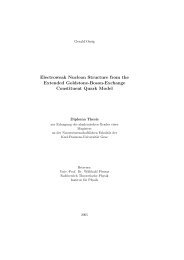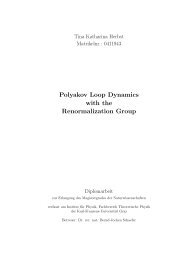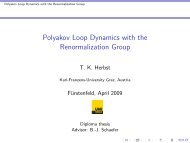The QCD Quark Propagator in Coulomb Gauge and - Institut für Physik
The QCD Quark Propagator in Coulomb Gauge and - Institut für Physik
The QCD Quark Propagator in Coulomb Gauge and - Institut für Physik
You also want an ePaper? Increase the reach of your titles
YUMPU automatically turns print PDFs into web optimized ePapers that Google loves.
Chapter 6. Nucleon Form Factors <strong>in</strong> a Covariant Diquark-<strong>Quark</strong> model 67<br />
In set B the amount of attraction provided by axial-vector correlations must be matched<br />
by that provided by the pion cloud. This highlights the constructive <strong>in</strong>terference between<br />
the contribution of these two effects to a baryons’ mass. It is related <strong>and</strong> noteworthy<br />
that m 1 + − m 0 + is only a reasonable approximation to M ∆ − M N = 0.29 GeV when pion<br />
cloud effects are ignored: set A, m 1 + − m 0 + = 0.21 GeV cf. set B, m 1 + − m 0 + = 0.10 GeV.<br />
Pla<strong>in</strong>ly, underst<strong>and</strong><strong>in</strong>g the N-∆ mass splitt<strong>in</strong>g requires more than merely reckon<strong>in</strong>g the<br />
mass-scales of constituent degrees of freedom.<br />
6.4 Electromagnetic current operator<br />
<strong>The</strong> nucleon’s electromagnetic current is<br />
J µ (P ′ , P) = ie ū(P ′ ) Λ µ (q, P) u(P) , (6.48)<br />
(<br />
= ie ū(P ′ ) γ µ F 1 (Q 2 ) + 1<br />
)<br />
2M σ µν Q ν F 2 (Q 2 ) u(P) , (6.49)<br />
where P (P ′ ) is the momentum of the <strong>in</strong>com<strong>in</strong>g (outgo<strong>in</strong>g) nucleon, Q = P ′ − P, <strong>and</strong> F 1<br />
<strong>and</strong> F 2 are, respectively, the Dirac <strong>and</strong> Pauli form factors. <strong>The</strong>y are the primary calculated<br />
quantities, from which one obta<strong>in</strong>s the nucleon’s electric <strong>and</strong> magnetic form factors<br />
G E (Q 2 ) = F 1 (Q 2 ) − Q2<br />
4M 2F 2(Q 2 ) , G M (Q 2 ) = F 1 (Q 2 ) + F 2 (Q 2 ) . (6.50)<br />
In equation(6.48), Λ µ is the nucleon-photon vertex, which we construct follow<strong>in</strong>g the<br />
systematic procedure of reference[OPS00]. This approach has the merit of automatically<br />
provid<strong>in</strong>g a conserved current for on-shell nucleons described by Faddeev amplitudes of the<br />
type we have calculated. Moreover, the canonical normalisation condition for the nucleons’<br />
Faddeev amplitude is equivalent to requir<strong>in</strong>g F 1 (Q 2 = 0) = 1 for the proton. <strong>The</strong> vertex<br />
has six terms, which are depicted <strong>in</strong> figure 6.1. Here we describe the key elements <strong>in</strong> the<br />
construction.<br />
In order to make this vertex more explicit, we write the scalar <strong>and</strong> axial-vector components<br />
of the nucleons’ Faddeev amplitudes <strong>in</strong> the form [cf. equation(6.19)]<br />
Ψ(k; P) =<br />
[<br />
] [<br />
Ψ 0 (k; P)<br />
Ψ i µ (k; P) =<br />
]<br />
S(k; P)u(P)<br />
A i µ (k; P)u(P) , i = 1, . . .,4. (6.51)<br />
For explicit calculations, we work <strong>in</strong> the Breit frame: P µ = P BF<br />
µ −Q µ /2, P ′ µ = P BF<br />
µ +Q µ /2<br />
<strong>and</strong> P BF<br />
µ = (0, 0, 0, i √ M 2 n + Q2 /4), <strong>and</strong> write the electromagnetic current matrix element



